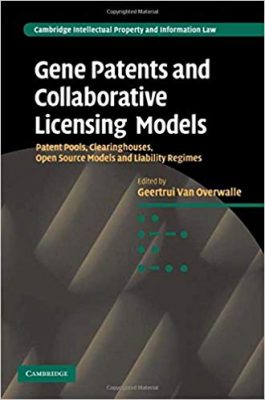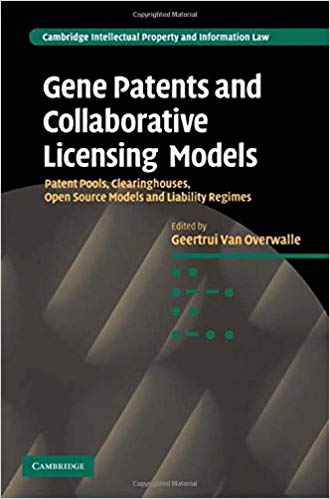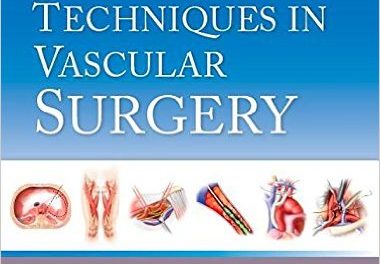 Editor: Geertrui Van Overwalle
Editor: Geertrui Van Overwalle
Publisher: Cambridge University Press – 477 pages
Book Review by: Nano Khilnani
In today’s age of information technology, the number of activities, companies, and laws have been growing at a faster pace than ever before in history. Innovation has become the new key to wealth, as it enables people to create new products that save effort and time (time is money), increase efficiency by getting more work done in less time, and reduce or minimize repetitive tasks and hopefully, eliminate hassles.
Some individuals and firms race to create new products and patent them, while others attempt to copy the technology they’re based on, and mass-produce them in their get-rich-quick schemes.
This book is about preventing such theft and ensure that all parties play a fair-add-square game.
Thirty-one specialists on a large range of areas including biochemistry, biodiversity, bioengineering, biotechnology, business assets protection, copyrights, genetics, information technology, intellectual property law and licensing, international law, patent law, and related areas, wrote the chapters of this wide-ranging book on intellectual property protection.
They are from all around the United States and 12 other countries – Australia, Belgium, France, Germany, Greece, Japan, the Netherlands, Romania, Russia, Ukraine, the United Kingdom, and Venezuela.
We list the chapters of this book below to provide you an overview of its coverage and contents:
- Part I – Patent Pools
- Patent pooling for gene-based diagnostic testing: conceptual framework
- Case 1. The MPEF LA Licensing Model: What problem does it solve in bio-pharma and genetics?
- Case 2. The SARS case: IP fragmentation and patent pools
- Critical analysis of patent pools
- Part II – Clearinghouses
- Clearinghouse mechanisms in genetic diagnostics: conceptual framework
- Case 3. The Global Biodiversity Information Facility (GBIF): An example of an information clearinghouse
- Case 4. Birchbob: An example of a technology exchange clearinghouse
- Case 5. The Public Intellectual Property Resource for Agriculture (PIPRA): A standard license public sector clearinghouse for agricultural IP
- Case 6. The Science Commons Materials Transfer Agreement Project: A standard license clearinghouse?
- Case 7. The collective management of copyright sand neighboring rights: An example of a royalty collection clearinghouse
- Comment on the conceptual framework for a clearinghouse mechanism
- Part III – Open Source Models
- Open source genetics: Conceptual framework
- Case 8. CAMBIA’s Biological Open Source Initiative (BiOS)
- Case 9. Diversity Arrays Technology Pty. Ltd. (DArT): Applying the open source philosophy in agriculture
- Critical commentary on ‘open source’ in the life sciences
- Several kinds of ‘should’: The ethics of open source in life sciences innovation
- Part IV – Liability Regimes
- Pathways across the valley of death. Novel intellectual property strategies for accelerated drug delivery
- Case 10. The International Treaty on Plant Genetic Resources for Food and Agriculture (ITGRFA). The Standard Transfer Agreement as implementation of a limited compensatory liability regime
- Critical analysis: property rules, liability rules and molecular futures. Bargaining in the shadow of the cathedral
- Part V – Different Perspectives
- Gene patents: from discovery to invention: A geneticist’s view
- ‘Patent tsunami’ in the field of genetic diagnostics: A patent practitioner’s view
- Gene patents and clearing models: Some comments from a competition law perspective
- Access to genetic patents and clearing models: An economic perspective
- The role of law, institutions and governance in facilitating access to the scientific research commons: A philosopher’s perspective
- Part VI – Summary and Concluding Analysis
- Of thickets, blocks and gaps: Designing tools to resolve obstacles in the gene patents landscape
A pioneering work, this book is a crucial, important. and timely one on a matter that has become a central focus in today’s business and trade news: intellectual property theft. This is a must-read for all those involved in protecting their own business assets, or helping clients in that mission.
Editor:
Geertrui Van Overwalle is Head of the research group Gene Patents and Public Health at the Centre for intellectual Property Rights in the Faculty of Law at the University of Leuven in Leuven, Belgium. She is Professor of Patent Law and New Technologies at the Tilburg Institute for Law, Technology and Society at the University of Tilburg in the Netherlands.







